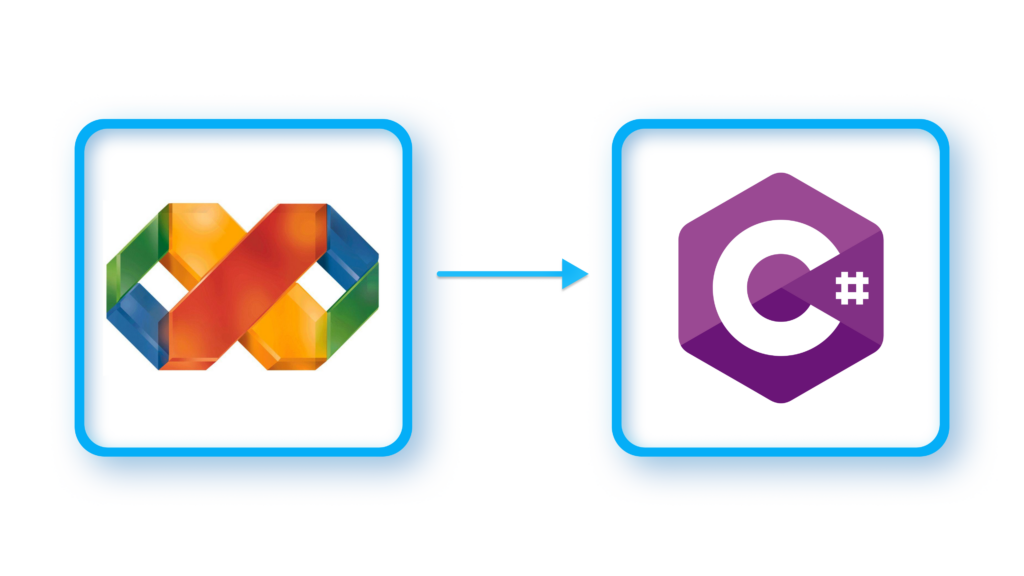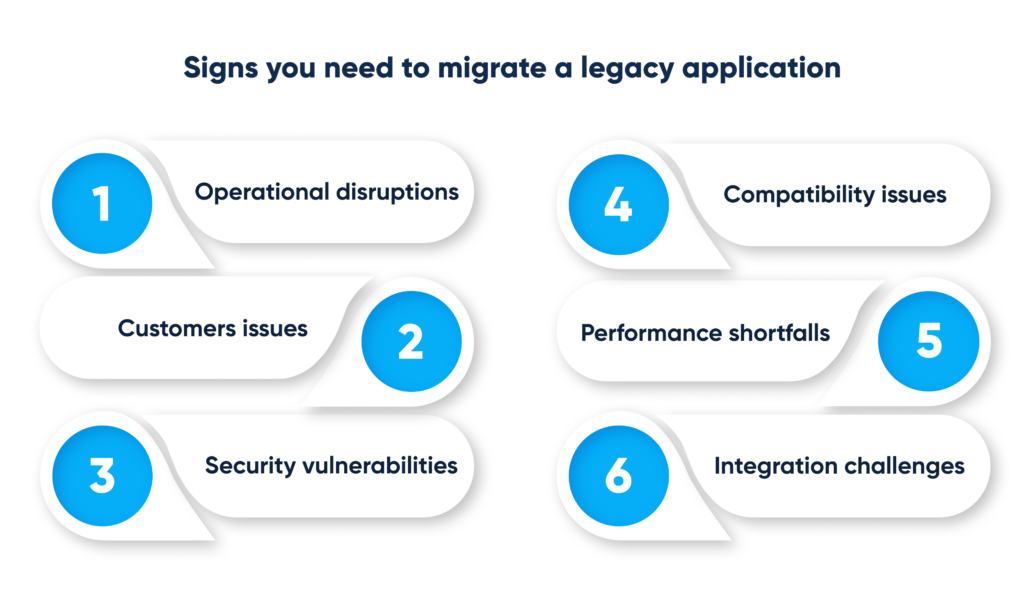VB6 to C# migration: automated vs manual conversion

As the technological landscape evolves dynamically, staying competitive becomes more and more important. Legacy applications often become major roadblocks speaking about market changes, customer expectations, digital transformation, strategic partnerships, and sustainability.
That’s why business leaders across industries are considering:
VB6 (Visual Basic 6), first launched in the late 1990s, was undoubtedly very powerful and had immense impact. As time went on, multiple factors started nudging business leaders towards considering better alternatives. VB6 support was discontinued, which means those still utilizing it don’t receive regular updates and patches. Without active mainline support, business leaders might face various challenges – security vulnerabilities, compatibility issues, performance regression, and more.
Technology migration also shows dedication to innovation and progress, which improves brand perception, customer trust, and even employee morale.
Looking for a reliable VB6 migration partner?
Learn more about VB6 migration services.
VB6 migration: technology dive-in
Visual Basic 6 (VB6) is a programming language, mostly known for its English-like syntax, visual environment, integrated IDE, Rapid Application Development (RAD), as well as other useful features facilitating accessibility. While VB6 was being actively used to deliver desktop applications, it already became outdated and unsuitable for modern software development due to limited features.
VB6, while being easy to learn and write, became outdated and unsuitable for modern software development. .NET and C# bridged the gap and became popular alternatives presenting some future-proof opportunities.
More and more organizations, no matter the industry, are considering VB6 to .NET migration services today. And C# is no less popular among those.
By leveraging domain knowledge and experience, we talked about the VB6 to .NET migration approach before. Let’s discuss moving applications to C#.
VB6 to C# migration – a trend worth following
Upgrading your legacy applications (migrate VB6 to .NET, convert VB6 to C#), is about long-range justification. Modernizing outdated legacy applications, when you go from VB to C#, in the broader context of digitization, business automation, and changing market trends, is a future-looking undergoing for several good reasons.

These include:
- Software longevity and support
VB6 support was discontinued in 2008, which means VB6 systems aren’t receiving regular updates and patches. In contrast, C# is one of Microsoft’s primary programming languages, which receives uninterrupted support within the .NET framework.
The solution – VB6 migration.
- Talent pool
The number of proficient VB6 engineers possessing required technology expertise has been steadily declining. If compared, C# is very prominent for both its community and resources, which ensures onefold recruitment and way more space for problem-solving and innovation.
No wonder business leaders are approaching VB6 code migration projects.
- Improved security
As cyberattacks are becoming more sophisticated, regular updates and patches are getting increasingly crucial. .NET and C# are benefiting from Microsoft’s substantial security measures, which keep implemented software better fortified against threats.
Currently experiencing security challenges? Migrate VB6 to C#.
- Enhanced integration
As the business landscape is changing, cloud services and other modern tools are getting more indispensable. .NET and C# are providing robust integration capabilities, which enable business leaders to adapt and expand.
Keep up with the latest trends and migrate from VB6 to C#.
- Business performance and scalability
C# software can offer uncompromised performance and scalability if compared to insufficient VB6 applications.
- User expectations
C# software, built within the popular .NET platform, is providing various helpful UI/UX frameworks and tools, ensuring the modernized applications are aligned with current user expectations.
VB6 and C# comparison
Let’s look more closely at the differences between VB6 and C# programming:
| Feature/Aspect | VB6 | C# |
| Nature, paradigm | – Procedural programming – Limited object-oriented features | – Object-oriented programming – Supports functional concepts |
| Development environment | Visual Basic 6.0 IDE | – Visual Studio – Powerful debugging & profiling – Management tools |
| Supported platforms | Windows desktop | – Windows desktop, web, mobile – Multiple platforms (.NET Core, .NET 5/6+) |
| Runtime environment | VB6 Runtime | – .NET framework – .NET Core – .NET 5/6+ |
| Syntax | English-like syntax | C-style syntax |
| Memory | – Manual memory management – Automatic aspects (limited) | Garbage collection |
| Library & framework | – VBA library – ActiveX controls | – .NET libraries – NuGet package manager for third-party libraries |
| Community and support | Legacy community support | – Large, active community – Microsoft support (official) |
Why migrate legacy applications?

You know it’s time for modernization when noticing these signs:
- Operational disruptions, including downtimes, unexplained errors, or crashes
- Customer feedback about outdated user interfaces, lacking features, or similar customer issues
- Security vulnerabilities that can’t be addressed due to the nature of the programming language
- Compatibility issues with newer operating systems, software or hardware components, or databases
- Performance shortfalls when handling increased loads
- Integration challenges when introducing modern platforms, web services, or other
Automated migration
Automated migration is used to convert programming languages or platforms using specialized migration tools. Speaking about VB6 to C# migration, by using such tools, software developers can translate VB6 code and its associated components directly into C# code without complete application rewriting.
The process in a step-by-step breakdown:
- Initial assessment and inventory
- the analysis of the existing codebase to understand its structure, functionalities, dependencies
- the cataloging of forms, modules, classes, ActiveX controls, third-party components, and more
- Initial conversion – the use of the migration tool to translate VB6 constructs to their C# counterparts and convert UI components to their .NET equivalents
- Careful review – migration tools generate logs, error messages, and warning, which must be reviewed to understand potential issues
- Manual intervention and refinement – rewriting certain “problematic” sections, finding appropriate .NET replacements, handling functionalities, which are more complex, and more
- Thorough testing
- Additional optimization and refactoring
- Application deployment
- Post-migration support and maintenance
Manual migration
Manual migration means moving legacy code from technology to another by completely manually transferring or rewriting outdated applications or data, rather than using special migration tools or scripts for conversion. To handle manual migration, software developers must understand the original legacy application and recreate its functionality in the target technology, simultaneously ensuring necessary features are replicated.
VB6-based applications typically comprise user interfaces designed using older standards and components. When approaching manual migration, software developers can redesign and modernize existing interfaces using contemporary .NET components and principles.
Our company has proven its expertise in handling automated and manual migration multiple times.
While working on a recent project, we helped a company in modernizing their outdated legacy applications. Our team carefully investigated the functionality lacking optimization to rewrite some slow AutoCAD functions and migrate VB6 to VB.NET and then to C# code.
After analyzing legacy functionality, we performed automated conversion:
- We converted VBA to VB6 code
- Next thing, we covered VB6 to VB.NET conversion by using Visual Studio for the VB6 to C# migration
- Moving further, after covering VB6 to VB.NET migration, we could smoothly convert VB.NET to C# code
After covering these stages, we proceeded with:
- Dependency replacement
- WPF UI implementation utilizing MVVM Light
- Functionality extension
- Modular design
- Code separation
- Unit testing
Choosing between automated and manual migration
In the table below, we compared automated and manual conversion in brief:
| Feature/Aspect | Automated migration | Manual migration |
| Cost | Generally lower | Typically higher because of developer hours |
| Time | Faster conversion | Slower conversion, as code is being rewritten and adapted manually |
| Migration accuracy | Good for standard code | High, if approached correctly |
| Code quality | Very variable | Clean, idiomatic, and optimized |
| Customization | Limited to tool’s capabilities | Highly flexible and adaptable |
| Modernization | Limited to tool’s capabilities | Provides opportunity to refactor and modernize |
| Dependency handling | Can attempt automatic conversion or offer .NET equivalents | Deliberate decisions on redesign or replacement |
| Error handling | Manual review | Manual review |
| Integration | Limited to tool’s capabilities | Allows integration with modern .NET technologies |
| Maintenance | Might require manual tweaks after conversion | Better structured for simpler future maintenance |
VB6 to C# migration benefiting leaders across industries
While strategic VB6 to C# migration is beneficial across industries, it assumes special importance in segments where longevity and support, security, compatibility, business performance, and scalability are determinative. For these large industries, VB6 to C# conversion is about staying competitive and relevant in a hectic world where digitization directly translates to efficiency and growth.
These comprise:
Healthcare
Healthcare organizations have always been slow in adopting newer technologies for the following reasons:
- Regulatory compliance – software migration requires ensuring that the new systems are compliant with regulations like HIPAA, GDPR, DICOM, and others
- System interoperability – software migration involves ensuring that every implemented component can integrate with the new system, which can be challenging
- Patient safety – system failure can cause life-threatening consequences (false diagnoses or dosages, missed alerts, and more)
- Data security – any failure can cause data breaches, which poses reputational and financial danger
In the healthcare industry, VB6 to C# migration can improve the interoperability with devices and systems, noticeably accelerate data security and integrity, and enhance patient care through improved data analysis, telehealth capabilities, and integration with modern medical devices.
Banking and finance
Financial companies are also facing struggles with adopting modern technology, and not without reason:
- Legacy applications – financial institutions typically utilize legacy software deeply ingrained into their day-to-day operations, which means they require sufficient expertise to upgrade their systems
- Business continuity – financial institutions are operating in real-time and providing instant services, which means any downtime and interruption can cause significant damage
In the banking and finance industry, VB6 to C# conversion can improve system stability and performance, greatly streamline data security, and simplify the integration with modern fintech solutions.
Government
Government institutions are also among those postponing modernization due to several factors:
- Bureaucratic hurdles – proposing and justifying approvals for prospective migration projects is a prolonged process with multiple decision-making layers
- Large scale – government-level solutions handle thousands of end-users, which means any interruption is unacceptable
- Custom solutions – over time, governmental agencies might have implemented various VB6 software, which must be migrated without losing their functionality
- Data security – governments handle confidential information, which means system migration can raise major concerns about potential data breaches
In the government sector, the conversion of legacy Visual Basic to C# can improve data handling and analytics, security, scalability, regulatory compliance, and transparency.
Construction
Construction leaders are another large group among sectors delaying modernization, and that’s due to:
- Legacy integration – construction organizations often have interdependent systems that manage different aspects, and upgrading one system without affecting other systems is a complex challenge
- Data loss – historical information is essential to automate everyday processes, including forecasting, which means system migration can raise serious concerns associated with data loss
In the construction domain, to convert Visual Basic to C# can enhance data analytics, predictive maintenance, reliability, uptime, integration capabilities, and efficiency.
How we can help
Abto Software assists organizations moving towards legacy modernization by leveraging extensive expertise. From evaluating legacy applications to handling meticulous planning, execution, validation, and maintenance, our engineers can cover complex projects, no matter the industry and objectives.
We provide end-to-end services to open up opportunities for further business growth.
Interested in VB to C#, VB to .NET code migration? Contact us to handle VB to C#, VB6 to .NET code conversion to facilitate your long-range transformation journey and enjoy business benefits right away!
We cover VB6 to C# or VB6 to .NET migration strategy planning, and more.
Our services:
- Business analysis and consulting
- Project setup and kick-off
- Code migration
- Code finalization
- Acceptance testing and improvement
- Quality assurance and deployment
Your benefits:
- Reduced time and cost
- Increased performance
- Optimized security
- Better compatibility, flexibility, scalability, and integration
VB6 to C# migration – a path to innovation.


